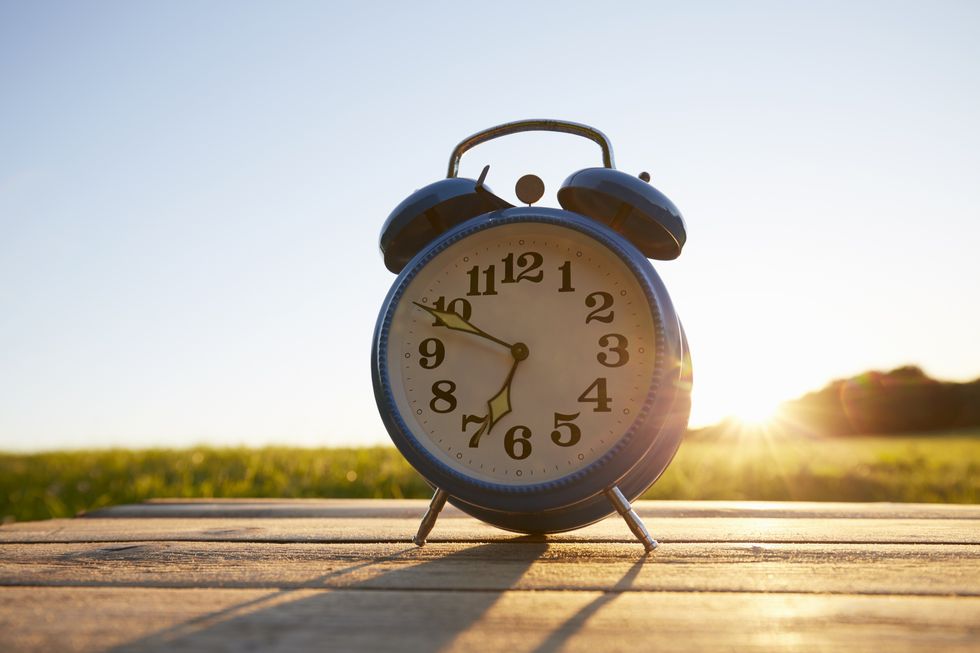After a long, sleepy winter, you're probably ready to bask in the sunshine. The desire to do so only ramps up in March when the first signs of spring emerge. The month brings a mix of excitement and joy—much like the feeling of biting into a fresh, zesty lemon bar! While the promise of longer days and warmer weather is enough to lift anyone's spirits, March also marks the return of Daylight Saving Time (DST).
For those who love spending time outside well into the evening, this shift is a welcome change. But for the night owls who cherish their precious morning sleep, losing an hour might not be as thrilling. Either way, there's no escaping the twice-a-year clock reset.
So, when exactly does daylight saving time start? And where does such a tradition come from? Here’s everything you need to know about DST before you spring forward!
What is Daylight Saving Time?
Daylight saving time is a way to conserve energy by utilizing more hours of sunlight as a natural source. The timeframe in which the sun rises and sets already depends on the season you're in. So, moving the clock forward an hour in the spring from standard time to DST is a way to do that. This year, daylight saving time starts on March 9, 2025.
Likewise, moving the clock backward from DST to standard time in the fall, heading into the winter, has a counter-impact, allowing you to adapt to the new season.
This method was introduced to the U.S. in 1918, initially being deemed "fast time." Now being used for more than just one sole purpose, the U.S. is one of 70 countries around the globe to have adapted DST.
Is it Daylight "Savings" or "Saving" Time?
Although "Daylight Savings Time" might roll off the tongue better, the correct term is "Daylight Saving Time" without the extra "s." This is because in the context of the other two words, "saving" functions as an adjective rather than as a verb, which is why it appears in its singular form.
Why is Daylight Saving Time Observed?
Oh boy, is there a lot here! A few stories prevail about how the United States adopted the time change. Benjamin Franklin wrote an early "proposition" in a 1784 letter to The Journal of Paris, where he suggested the city could save 64,050,000 pounds of candle wax burned if only its citizens would rise with the sun. He also suggested firing cannons in every street as a city-wide alarm clock, so the letter is taken mainly as satire (thank goodness).
In 1916, Germany was the first country to enact daylight saving time to save money on energy costs during WWI; the United States and much of Europe followed suit. Then, comes a slightly chaotic time for daylight saving time in America—the federal law was repealed after the war, reinstated during WWII, and made optional after that war ended. This "choose-your-own-adventure" DST made traveling between states an absolute nightmare. (Who could have seen that coming? 😂)
Finally, in 1966, the federal government passed the Uniform Time Act, which standardized DST for six months, from April to October. It was extended twice more to seven months in 1986, and our current eight months in 2005.
Is Daylight Saving Time Becoming Permanent?
In recent news, the Sunshine Protection Act was proposed as a United States federal law that would make daylight saving time permanent, meaning no more changing the clocks twice a year! On March 15, 2022, the U.S. Senate passed the bill unanimously. Currently, it still needs to be discussed by U.S. House of Representatives before it can be signed into law by the President.
Eliminating what feels like an arbitrary time switch sounds like a simple plan, one most people could get behind if they dislike standard time. However, some scientists and experts warn that there are serious health risks. The American Academy of Sleep Medicine's (AASM) official position cites an "abundance of evidence" showing that the abrupt switch from Standard Time to DST leads to an "increased risk of adverse cardiovascular events, mood disorders, and motor vehicle crashes." Even without the sudden change, DST is less aligned with our natural circadian biology. The AASM concludes that the seasonal time change should be eliminated but in favor of year-round standard time.
How Can You Adjust to Daylight Saving Time?
You may not be able to avoid the time change, but you can avoid some of its negative effects by making a few simple tweaks to your routine!
Leading up to the end of DST, challenge yourself to stay up an extra hour at night and wake up an hour later to help your body adjust to the future time change. You can even change your clock early to trick your brain into getting used to the new time. Do this by adjusting your clock to be 15 minutes behind each day leading up to the end of daylight saving time.
Another helpful way to reduce the health effects of daylight saving time is by ensuring you get enough sunlight to regulate your internal body clock. Because the end of DST means fewer hours of sunlight during the day, it’s important to spend as much time outside soaking up the sun so that you’ll feel less tired.
What States Are Getting Rid of Daylight Saving Time?
Hawaii and Arizona already observe permanent standard time and have done so since 1967 and 1968, respectively. Their reasons were the same: both states get lots of sunlight year-round anyway! A handful of U.S. territories also don't observe the change for the same reason, including Puerto Rico, Guam, American Samoa, and the U.S. Virgin Islands.
As of October 2022, 29 states had introduced state legislation addressing DST, with the majority wanting to make it permanent. Under federal law, states can opt out of daylight saving time and remain on Standard Time as Hawaii and Arizona have. However, they are not allowed to remain on daylight time without congress enacting a federal law or gaining state approval from the U.S. Secretary of Transportation saying that the change would support commerce.
Fun fact: Former President Woodrow Wilson once abolished a year long daylight saving time! It was at the request of the farmers at the time, but it was later re-established by President Franklin Delano Roosevelt who called it necessary for "War Time," and its use of conserving energy. However, things were set in a regular order with the aforementioned 1966 Uniform Time Act.
Love it or hate it, most people have learned to live with switching our clocks twice a year.

Nitya Rao is the editorial assistant at The Pioneer Woman, covering stories ranging from food, fashion, beauty, lifestyle, news, and more.













